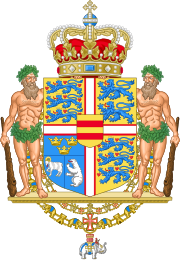

 |
|---|
The Strukturreformen or Kommunalreformen (English: structural reform) meant large changes to the administrative structure of local government in Denmark. The reforms reduced 271 municipalities to 98 and replaced 13 counties with 5 regions.[1] In addition, 14 state offices and Copenhagen's Overpresidium were replaced by 5 state administrations.[2] The Capital City Development Council (HUR) and the Capital City Hospital Association (H:S) were closed, and a number of other structures were reformed.[3]
The reform was labelled the most radical reform of the political administrative system since the first democratic constitution in 1849.[4] It was described by some as the "the greatest centralization in Danish history since the introduction of the dictatorship".[5]
The report was published on 9 January 2004 contained various proposals. One controversial reform was that the Danish government would take over the running of hospitals along with the total abolition of counties and replacement by regions. This was presented on 14 January 2004 in the Vingsted center in Egtved Municipality in the presence of almost 1,000 politicians, civil servants, administrative researchers and over 100 journalists. There was a majority in support for the reforms after the Danish People's Party gave its support to the Venstre–Conservative People's Party coalition governments reform on 24 June 2004 in the Structure Agreement. The structural reform was adopted by the Danish Parliament on 16 June 2005 and entered into force on 26 June 2005 with the first election for the new municipalities and regions on 15 November 2005.
Immediately before the reform, the number of municipalities in Denmark had been reduced from 275 to 271, when the 5 municipalities in Bornholm County were merged after a local referendum on 29 May 2001. The new Bornholm Municipality came into being on 1 January 2003. This also reduced the number of county municipalities to 13. Ærø Municipality was part of the structural reform and was formed on 1 January 2006 by merging two municipalities so there were 270 municipalities. On 1 January 2007, 238 municipalities were merged into 66 new municipalities, and 13 county municipalities and 3 municipalities (Bornholm, Frederiksberg and Copenhagen) with county powers for 5 regions. In addition, 30 municipalities remained independent after 1 January 2007 and were thus not merged with other municipalities either immediately before or after 1 January 2007. Lolland and Sønderborg municipality consist of seven (7) old municipalities each, which is the highest among the newly formed municipalities. Ertholmene was not included in the reform, and is still today administered by the Ministry of Defence.
The structural reform replaced the structure of municipalities and county municipalities, which were introduced with the 1970 Danish Municipal Reform. An overview of both the old and the new structure can be seen on the page about Denmark's municipalities. The merged municipalities were decided in 2006 by an amalgamation committee, which consisted of the municipal board that was elected at the 2005 Danish local elections. In these municipalities, the election period for the old municipal councils was extended by one year, so that the old structure could function while the new one was built up.[6]
- ^ Kjaer, Ulrik; Hjelmar, Ulf; Leth Olsen, Asmus (August 2010). "Municipal Amalgamations and the Democratic Functioning of Local Councils: The Case of The Danish 2007 Structural Reform". Local Government Studies. 36 (4): 569–585. doi:10.1080/03003930.2010.494112. ISSN 0300-3930.
- ^ Vrangbæk, Karsten (April 2010). "Structural Reform in Denmark, 2007–09: Central Reform Processes in a Decentralised Environment". Local Government Studies. 36 (2): 205–221. doi:10.1080/03003930903560562. ISSN 0300-3930.
- ^ Schmidt, Morten; Schmidt, Sigrun Alba Johannesdottir; Adelborg, Kasper; Sundbøll, Jens; Laugesen, Kristina; Ehrenstein, Vera; Sørensen, Henrik Toft (July 2019). "<p>The Danish health care system and epidemiological research: from health care contacts to database records</p>". Clinical Epidemiology. 11: 563–591. doi:10.2147/clep.s179083. ISSN 1179-1349. PMC 6634267. PMID 31372058.
- ^ Andersen, Pernille Tanggaard; Jensen, Jens-Jørgen (2010). "Healthcare reform in Denmark". Scandinavian Journal of Public Health. 38 (3): 246–252. doi:10.1177/1403494809350521. ISSN 1403-4948. JSTOR 45150377. PMID 19850650.
- ^ "Vestegnsborgmestre råber regeringen op: Jeres sundhedsreform fører til den største centralisering i næsten 20 år". Sundhed. 2024-10-21. Retrieved 2024-10-28.
- ^ "Regioner, landsdele og kommuner, v1:2007-". www.dst.dk.